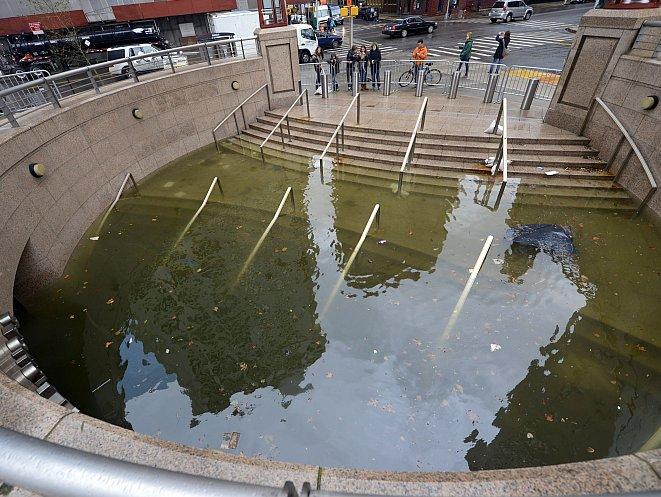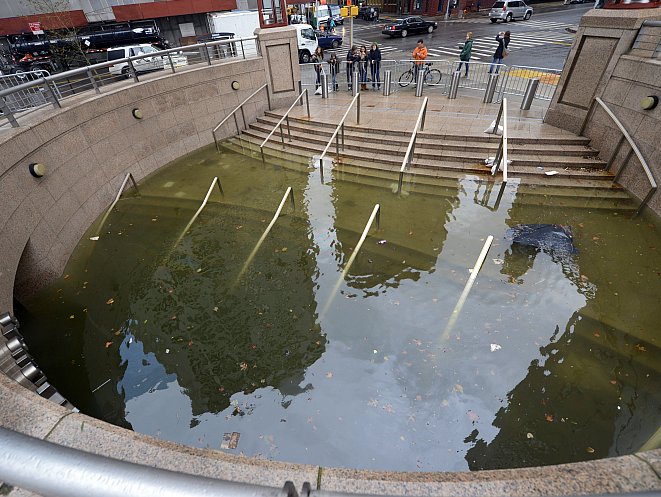Sandy caused unprecedented damage on the U.S. East Coast. As cleanup work and repairs begin, so do the damage cost calculations. According to some researchers, the total bill could be as high as $100 billion.
Metropolitan Transportation Authority (MTA) Chairman Joseph Lhota on Oct. 30 said the storm’s impact on New York’s subway was “worse than the worst case scenario.” Despite the heavy damage to private property, it is transportation infrastructure that will cost the most to repair, say researchers.
Columbia Researchers Predict Record Damage
Klaus H. Jacob of Columbia University and his team calculated the potential cost of a large storm hitting the Metropolitan East Coast (MEC), as early as 2011. “We infer that total losses from an equivalent Category 3 storm hitting the MEC region may amount anywhere from $50 to $100 billion,” it says in the report titled, “Risk Increase to Infrastructure Due to Sea Level Rise,” published last year.
Based on barometric pressure and wind speed, Sandy was already weaker than Category 3 when it hit the United States. It did manage, however, to increase the sea level more than 13 feet around New York according to the National Hurricane Center. It was the rise in sea levels that the Columbia researchers feared most.
“Bridge access roads, entrances to road and rail tunnels, including subways and ventilation shafts, but also non-transportation infrastructures such as storm sewer and wastewater processing plants are located at critical low elevations. They are exposed to coastal or riverine flooding and hence can be subjected to related interruptions of services,” says the report.
Jacob and his team calculated that a 13–14 feet rise in sea levels would cost the MEC region $50billion–$100 billion. The numbers are based on an extensive analysis of historical precedents worldwide.
The total includes all type of damages, not just flooding. They are the results of an event that should only occur once every 100 years, according to the researchers.
MTA Network Especially Costly to Repair
“The vast majority of New York City’s and the MEC region’s basic infrastructure (in its narrow sense of engineered structures and systems) was built and developed between about 100 and 50 years ago,” says the Columbia report.
The New York subway system is old, large, and very complex—and large parts of it have been completely flooded, reports the MTA. “The South Ferry station was filled track to ceiling with water as were several of the subway tunnels,” it says on the MTA website.
Pumping out the water and cleaning the system so it is free of salt water will take time and money. In addition, the MTA system is so old that some replacement parts might be out of production. In addition, the personnel trained to handle obsolete parts could long be retired. This is why some parts of the system might have to be completely replaced with new infrastructure.
The MTA has already committed to upgrades totaling $16.5 billion for its Capital Program through 2014, consisting of large but only select upgrades. The price for repairing and refurbishing much larger parts of the subway system could make up a big chunk of the estimated $50 billion–$100 billion in damages.
Drag on Economy Likely Manageable
“It is a big hit to wealth, but once the various offsetting effects are taken into account, it will likely have a very small impact on economic growth,” writes Bank of America in a note.
Citing that the MEC region represents about 25 percent of the U.S. economy and that the city ground to a complete standstill for two days (and counting), Bank of America makes the following calculation: “US daily GDP is about $60bn on week-days and if Sandy eliminated the equivalent of 2 days of GDP, that’s a $30bn drag.” It concludes that this would reduce Q4 annualized GDP growth by 0.8 percentage points.
The report provides further grounds for optimism: “History shows that natural disasters early in a quarter are usually offset by increased activity later in the quarter, leaving few visible scars on the macro data.” The analysts also say rebuilding activity and spending that was postponed help to mitigate the drag on growth.
The Epoch Times publishes in 35 countries and in 19 languages. Subscribe to our e-newsletter.







